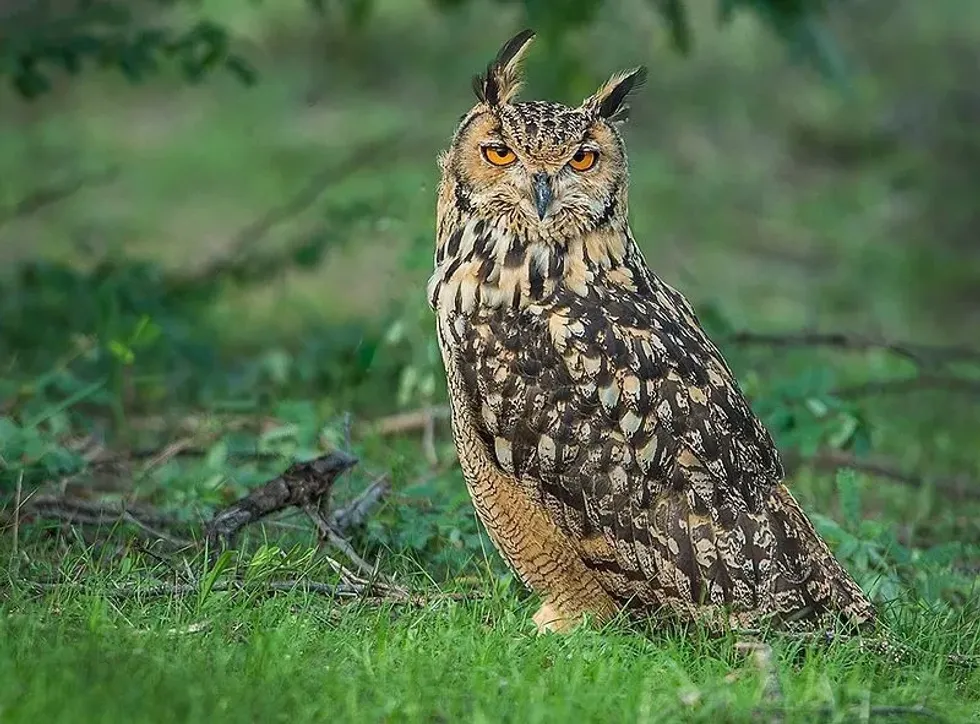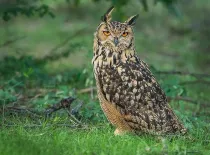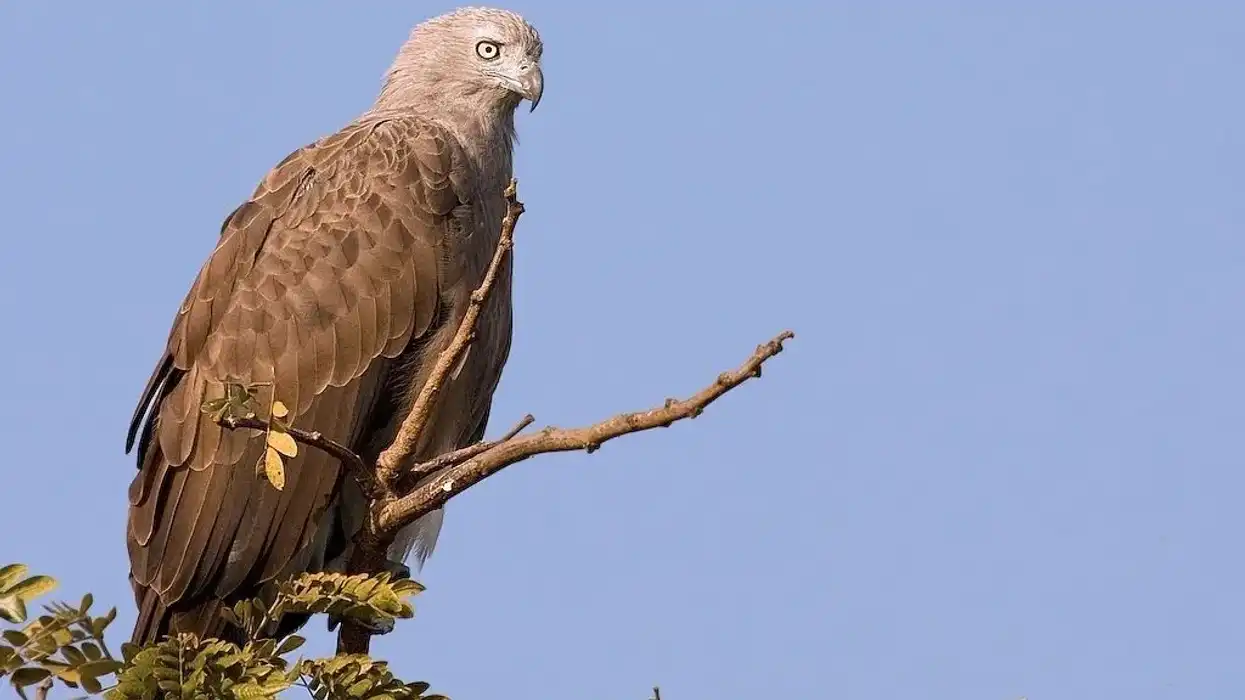The Indian eagle owl, Bubo bengalensis, is a South Asian bird with a wide range of geographical distribution in the countries of India, Nepal, and Pakistan. The birds are brownish-gray or beige in color. The lower body parts and tufts are paler with dark brown lines.
Their diet consists of rodents, insects, small mammals, and birds. One striking feature about the species is the color of its eyes which is bright orange. A breeding pair lays four eggs on average, in and around April.
It is to be noted that the species was previously considered a subspecies of the Eurasian eagle-owl (Bubo bubo) with diverse hunting grounds in Korea, Mongolia, Spain, Sweden, and others. The birds from India are also known as the Bengal eagle-owl and rock eagle-owl.
If you liked reading about this owl from India, then check out our barn owl facts and harpy eagle facts.
Indian Eagle-Owl Interesting Facts
What type of animal is an Indian eagle-owl?
The Indian eagle-owl (Bubo bengalensis) is a type of bird under the Animalia kingdom.
What class of animal does an Indian eagle-owl belong to?
The Indian eagle-owl (Bubo bengalensis) belongs to the class of Aves under the Animalia kingdom from the family of Strigidae.
How many Indian eagle-owls are there in the world?
The estimated population count of the Indian eagle-owl (Bubo bengalensis) and their parent species stands at 250,000-2,500,000.
Where does an Indian eagle-owl live?
The Indian eagle-owl (Bubo bengalensis) is commonly found in the Indian subcontinent, preferably in areas of hilly terrain, rugged landscape, a wooden county with ravines, rocky hills, semi-deserts with rocks, bushes, scrub forests, and even in mango orchards.
These birds usually hunt in the ground near rocky places with an elevation of 4921.2 ft (1500 m) and avoid extremely arid areas and evergreen forests.
They are a nocturnal species and spend most of their time on trees around rocky projections.
What is an Indian eagle-owl's habitat?
An Indian eagle-owl's (Bubo bengalensis) habitat consists of locations around the subcontinent of India, and its states of Kashmir and Assam. They are also found in other countries like the West Himalayas of Nepal, Myanmar, Burma, and Pakistan.
They prefer areas of medium to light forests and are specifically seen around rocky places. The birds avoid humid evergreen forests and dry areas.
They also love bush covered with ravines, steep banks of rivers, and similar locations. They spend most of their time under a shelter of bush or rocks, and sometimes even in large mango trees.
Who do Indian eagle-owls live with?
The rock eagle-owl is known to be territorial along with being one of the least sociable birds, which is why similarly the Indian eagle-owl is often seen alone.
How long does an Indian eagle-owl live?
The average life expectancy of the Bengal eagle owl can be estimated to be about four to 20 years in the wild.
How do they reproduce?
The breeding season begins from February-April but can differ in various other regions. In some places, it usually begins around October-May while in others, it begins in November-April.
The birds build their nests in an earthy region or a shallow scrape that must be protected with rocky projections, riverbanks, or ravines in a cliff. They are also known to nest on grounds under bushes, between rocks on a slope.
The female will usually lay about two to four eggs, white in color, round, oval in shape with a smooth texture. The incubation period lasts for about 35 days, after which the eggs hatch within 33 days.
What is their conservation status?
Even though the Bengal eagle owl's population is declining, their conservation status remains of Least Concern.
Indian Eagle-Owl Fun Facts
What do Indian eagle-owls look like?

Indian eagle-owls are large owls, similar in appearance to the subspecies, Eurasian eagle-owl, with a disc of brown-black borders, tufts, and banded primary feathers. The tail has a tawny band, wider than the ones which are black.
It also has a large patch on its folded wings and its claws are long while the joints of its toes are unfeathered.
The upper portion is usually a dark brown color while the lower portions are much paler and yellowish. There is a crown on their forehead and their eyes are orange in color.
They also have white spots and a dark streak on their back. The females are much larger in size than the males and the chicks are born with speckled white feathers that gradually turn brown.
How cute are they?
It is a large, cute owl with brown feathers and a fluffy body.
How do they communicate?
The male Indian eagle-owl call has a deeply resonant, hooting sound repeated at several intervals while the females have a slightly higher-pitched voice. They also produce a series of 'huwoo-huwoo' sounds along with a clucking noise.
How big is an Indian eagle-owl?
Similar to its subspecies, the Eurasian eagle-owl, Indian eagle-owls grow to a maximum length of 19.68-22.04 in (50-56 cm).
How fast can an Indian eagle-owl fly?
In comparison to the average speed of flight speed of a Eurasian eagle-owl, an Indian eagle-owl is estimated to fly at about 30-40 mph (48.2-64.3 kph).
How much does an Indian eagle-owl weigh?
The average weight of an Indian eagle-owl is about 38.80-70 oz (1100-1984 g).
What are the male and female names of the species?
A female owl is called a hen owl while a male owl is referred to as an owl.
What would you call a baby Indian eagle-owl?
Baby Indian eagle owls are called owlets or chicks.
What do they eat?
The diet of the large Indian eagle-owl consists of rodents like rice rats, mice, small mammals, reptiles, crabs, frogs, partridges, and other birds such as shikra, the spotted owlet, Indian rollers, and sometimes birds as big as a peacock are hunted for food.
Are they dangerous?
Owls are usually not a dangerous species but sometimes they can be if they feel threatened.
Would they make a good pet?
No, owls do not make a good choice because they are predatory in nature and do not do well in captivity. They are good-natured but tend to get aggressive when kept in confined spaces. As well as this, they are wild birds and should not be kept in captivity.
Did you know...
The Indian eagle-owl has a lot of superstitions surrounding its existence. The bird is usually seen as a bad omen in the countryside in India and has been used for many sacrifices in tribes for good fortune.
It is also believed that if an owl calls from the roof of your house then bad things will happen in your household.
It is to be noted that all of these are make-believe and should not be considered true, we don't want anyone having nightmares!
Where are Indian eagle-owls native to?
As the name of the bird suggests, the Indian eagle-owl is native to the Indian subcontinent, usually living in areas abundant with rocky hills, semi-deserts, wooded areas, scrublands, and mango orchards.
Naming the Indian eagle-owl
The Indian eagle-owl's name comes from its native habitat of the Indian subcontinent where the species thrives in its preferred habitats. The bird is also known as the rock eagle-owl and the Bengal eagle-owl.
Here at Kidadl, we have carefully created lots of interesting family-friendly animal facts for everyone to discover! Learn more about some other birds from our common nighthawk facts and short-eared owl fact for kids.
You can even occupy yourself at home by coloring in one of our free printable Indian eagle owl reading coloring pages.
Main image by Koshy Koshy.
Second image by Rudraksha Chodankar.









